So, you have a flat tire or one that’s leaking air. It’s not the end of the world. Luckily there are safe and cost-effective ways to properly repair most tire punctures. The purpose of this article is to show you the difference between a safe, permanent repair and a temporary string, plug or patch repair.
According to the National Highway Traffic Safety Administration (NHSTA) and the Tire Industry Association (TIA), the only method to properly repair a tire puncture is to fill the injury with a repair stem and back the stem with a repair patch. This is commonly known as a combination repair or a patch/plug repair.
Patch/plug repairs are most often performed using a one-piece repair unit that combines the repair stem and cap (or patch) into one unit. However, special circumstances may require the use of a two-piece combination repair (ex. If the angle of the puncture exceeds 35 degrees). The repair is then permanently bonded to the inside of tire and through the injury channel using a cold, chemical vulcanizing process.
The repair essentially becomes part of the tire, creating an air-tight seal that keeps air in and moisture and contaminants out (more on this procedure below).
Emergency roadside plug repairs are NOT intended to be a permanent tire repair. Plugs and string repairs are designed to get you back up and rolling long enough to get home or to the nearest service center to perform a proper tire repair.
The common misconception with plug and string repairs is that because they hold air, they are safe to use. While it is true that many plug repairs do a great job of keeping air in the tire, that’s only part of the equation. Because they’re not completely sealing the injury, plug repairs may allow air and moisture to penetrate the body of the tire. Over time, this could lead to a dangerous (or even deadly) blowout.
A Patch-Only Tire Repair Leaves Your Tire Susceptible to DamageA tire repair that uses only a patch is also NOT considered proper or safe. A properly installed patch will do a great job of allowing the tire to hold air. However, similarly to the plug-only repair, the patch does not fill the injury channel. Therefore, air and moisture could seep into the tire from the tread surface and eventually damage the tire.
A properly installed patch will do a great job of allowing the tire to hold air. However, similarly to the plug-only repair, the patch does not fill the injury channel. Therefore, air and moisture could seep into the tire from the tread surface and eventually damage the tire.
Only a proper patch/plug repair completely seals the puncture from inside the tire and through the entire injury channel. There are a few extra steps necessary to perform a proper tire repair in accordance with industry guidelines. We’ve developed a simple acronym to help organize and remember the steps: R.E.P.A.I.R.
 It can also be determined if the puncture did any significant damage to the cords or belts.
It can also be determined if the puncture did any significant damage to the cords or belts. The over-buffed area of the inner liner is treated with a thin layer of rubber sealant, and the excess repair is trimmed to approximately ¼” above the tread surface.
The over-buffed area of the inner liner is treated with a thin layer of rubber sealant, and the excess repair is trimmed to approximately ¼” above the tread surface.There are a number of factors that may determine whether or not your tire is safe to repair. These factors fall into three main categories:
 Excessive wear, casing separation, impact damage and other conditions may make it unsafe to properly repair your tire. For a more comprehensive list of repairable vs. non-repairable conditions visit our blog Can Your Tire Be Repaired?
Excessive wear, casing separation, impact damage and other conditions may make it unsafe to properly repair your tire. For a more comprehensive list of repairable vs. non-repairable conditions visit our blog Can Your Tire Be Repaired?The occasional flat or leaky tire is an unavoidable part of life. But, taking shortcuts to repair it can be dangerous to you and your passengers. Take the time and do the research to do the job right and/or find a reputable tire repair shop trained in proper tire repair procedure.
By Cheryl Knight
Writer
Updated on Apr 27, 2022
Reviewed by Carrie Adkins, VP of Content.
Knowing how to properly repair a punctured tire can save you money, as well as keep you from being
stranded
on the side of the road.
Luckily, a couple of easy-to-follow methods exist for repairing a punctured tire.
While you should ultimately have your tires inspected and replaced if necessary following a tire repair, the methods below provide a great temporary fix to a punctured tire until you can get to a tire store.
Here's how to plug and patch a tire.
RECOMMENDED
No spam or unwanted phone calls · No long forms · No fees, ever
ZIP Code
ZIP Code
Find insurance savings (100% Free)
Using a tire plug to repair a punctured tire
A tire plug kit helps patch a tire quickly and easily. Considered a safer alternative to patches and sealant, a tire plug actually inserts into the tire. It then expands to plug any holes.
Here are the steps for how to plug a tire.
Step 1: Remove tire. Start by removing the punctured tire.
Step 2: Pull out object. Pull out the object that punctured the tire.
Step 3: Clean hole. Clean the puncture hole using a rasp tool, which you can find at brick-and-mortar stores like The Home Depot and Advanced Auto Parts.
A tire plug kit should contain various tools, one of which is a rasp tool.
The rasp tool can help the plug hold by roughening the tire material in the hole where you want to place the plug.
Step 4: Apply adhesive. Apply the adhesive that came with the tire plug kit.
Common adhesives include rubber cement or some other type of glue.
This glue can initially help lubricate the puncture hole, making it easier to get the plug through.
Step 5: Insert plug. Using the insertion tool, which also comes with your kit, insert the plug into the puncture hole.
While difficult to insert in some cases, you can get the plug to fit by squeezing down one of the end of the plug material.
Once the adhesive has dried, cut away any excess material from the plug using a razor or knife.
Step 6: Place air in the tire. Fill the tire to the recommended air pressure, which you can find inside the wall of the tire or in the owner's manual.
Test the seal of the tire plug by squirting a soap/water mix on the puncture area.
If needed, apply more adhesive or try using another plug.
Using tire sealant to repair a punctured tire
Flat tire sealant, such as
Fix-a-Flat
, provides a fast and easy way to fix a punctured tire—as long as the puncture is not too large. You should have the tire professionally repaired or replaced if the puncture is larger than one-quarter inch.
The following steps walk you through the process of using sealant to patch your tire.
Step 1: Remove the object. First, remove the object that punctured your tire.
Step 2: Position the tire. Position the tire so that the valve stem rests at the top of the wheel.
Remove the valve stem cap.
Step 3: Attach tire sealant nozzle. Attach the nozzle from the tire sealant can to the valve stem.
Press the button releasing the sealant into the tire.
Step 4: Drive the car. Drive the car around until the sealant has spread evenly throughout the tire.
This step is necessary to keep the sealant from forming a lump in one area and unbalancing the tire.
Step 5: Replace the tire. Make sure to replace the tire within a certain time limit.
Sealants are only meant to get you to where you can get the tire replaced. Most sealants only last for 100 miles or three days.
To minimize the chances of a punctured tire, try to avoid driving over potholes and other rough areas in the street, as well as on the side of the road where debris collects.
Even given your best efforts, a punctured tire is bound to happen. And when it does, you can use one of the above methods to fix it on the spot.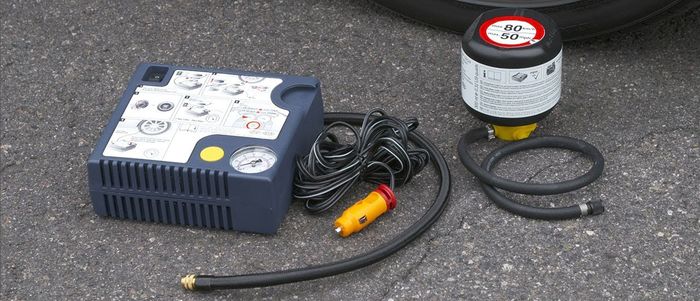 Just remember to take your car to a professional tire shop to have the punctured tire inspected for safety, and replaced if necessary. And don't forget to keep an eye out for
Just remember to take your car to a professional tire shop to have the punctured tire inspected for safety, and replaced if necessary. And don't forget to keep an eye out for
slow leaks
.
If your tires were damaged in an accident or another covered peril, you should contact your insurance company.
Jerry
is the easiest and most effective way to find a car insurance policy that is customized for you.
After providing you with a comprehensive cross-analysis of the best policies across providers, Jerry will handle the phone calls, paperwork, and renewals for your top pick so that you don’t have to. They even help cancel your old policy! So why do all that extra work when Jerry can do it better?
RECOMMENDED
Judith switched to Progressive
Saved $
725
annually
Alexander switched to Travelers
Saved $
834
annually
Annie switched to Nationwide
Saved $
668
annually
02/22/2018
Despite the objective importance of the spare tire, not all drivers always have it with them.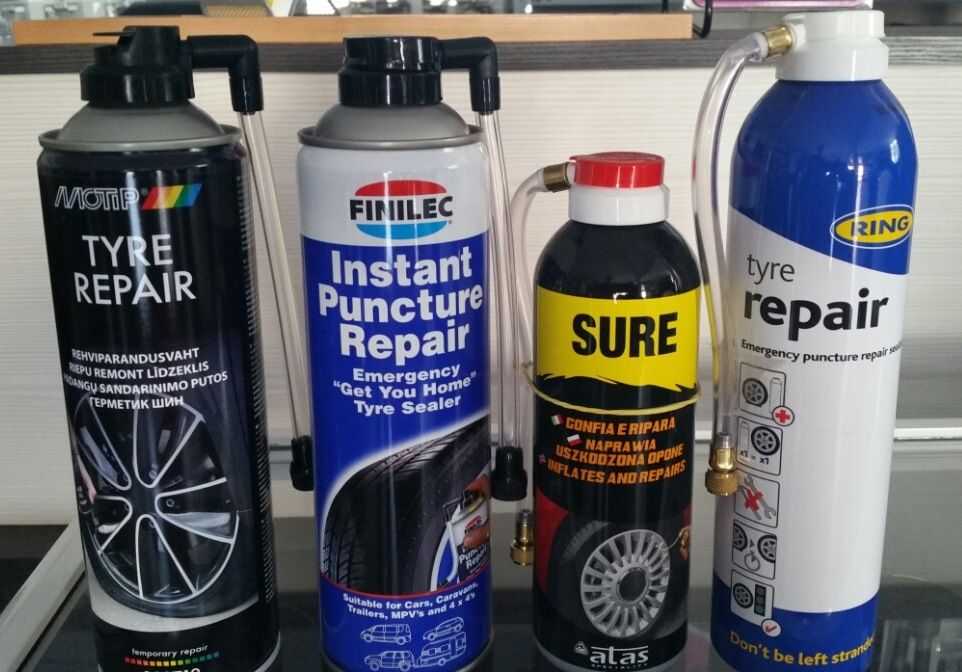 Some do not carry a spare tire out of hope or belief that their tires are invulnerable. Others deliberately take this step, as they stocked up with a special tool in advance, which, if necessary, can eliminate a tire puncture along the way. What else can be used and how to do it right? Let's figure it out.
Some do not carry a spare tire out of hope or belief that their tires are invulnerable. Others deliberately take this step, as they stocked up with a special tool in advance, which, if necessary, can eliminate a tire puncture along the way. What else can be used and how to do it right? Let's figure it out.
Contents of :
Conventionally, all methods for express tire repair can be divided into two categories:
Consider ways to restore a damaged tire on the road. The first three methods are temporary. The latter, with the right approach, allows you to completely restore the tire.
 e. preventive). A special sealing compound is pumped into all four undamaged tires. While driving, it is inside the wheel in liquid form. If the tire suddenly loses its tightness, then this composition, leaving together with the air, clogs the slot in a few seconds. This method is relevant if you have a long trip under time constraints.
e. preventive). A special sealing compound is pumped into all four undamaged tires. While driving, it is inside the wheel in liquid form. If the tire suddenly loses its tightness, then this composition, leaving together with the air, clogs the slot in a few seconds. This method is relevant if you have a long trip under time constraints. 
After removing the foreign object, the hole is processed with an awl with abrasive edges: this tool must be inserted into the puncture and cleaned and worked out several times with intense reciprocating movements. Then the raw rubber tow is removed from the package and inserted into the eye of the second awl so that both ends are the same length. The hole in the tire and the raw rubber is treated with an activator. Next, the awl is inserted into the puncture in such a way that small ends of the tourniquet, about a centimeter long, remain outside. After 5 minutes, the excess remaining on the surface is cut off. This method can also successfully eliminate small side cuts.
Then the raw rubber tow is removed from the package and inserted into the eye of the second awl so that both ends are the same length. The hole in the tire and the raw rubber is treated with an activator. Next, the awl is inserted into the puncture in such a way that small ends of the tourniquet, about a centimeter long, remain outside. After 5 minutes, the excess remaining on the surface is cut off. This method can also successfully eliminate small side cuts.
There is a technique that allows using wire and several bundles of raw rubber to get rid of even extensive side damage to tires. However, it is quite difficult to implement and not every driver will be able to implement it.
Consider a few well-known tools that are most widely used to repair punctures:
 It works in the same way as most sealants: the container is thoroughly shaken, after that a hose is attached, and the contents from the container are completely pumped into the tire. The maximum diameter of the repaired hole is 4.5 mm. This is almost always enough to repair punctures caused by nails and screws.
It works in the same way as most sealants: the container is thoroughly shaken, after that a hose is attached, and the contents from the container are completely pumped into the tire. The maximum diameter of the repaired hole is 4.5 mm. This is almost always enough to repair punctures caused by nails and screws.
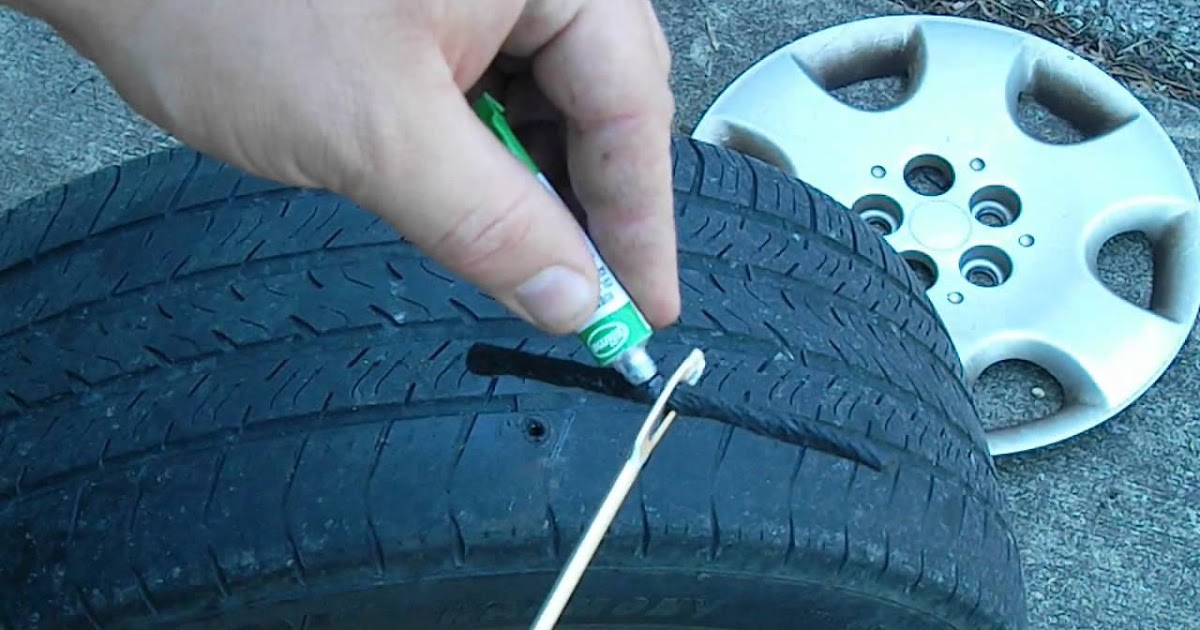
Our online store offers a wide range of tire repair products. You can order them through the TopDetal.ru website or by calling 8 800 444-75-16.
Also read on our website about the best liquid rubbers.
Return to the list
Another season of changing shoes is coming. And you may remember that on one of the tires after the last winter/summer there is a jamb - a small bump. I don’t want to run to the store for the sake of one new tire. We understand. Or maybe it looks even better if repaired?
Yes, not every wheel that meets with a nail, rebar sticking out of the ground or a sharp stone off-road is considered damaged. Everything, of course, depends on the scale of the damage and its location on the tire itself.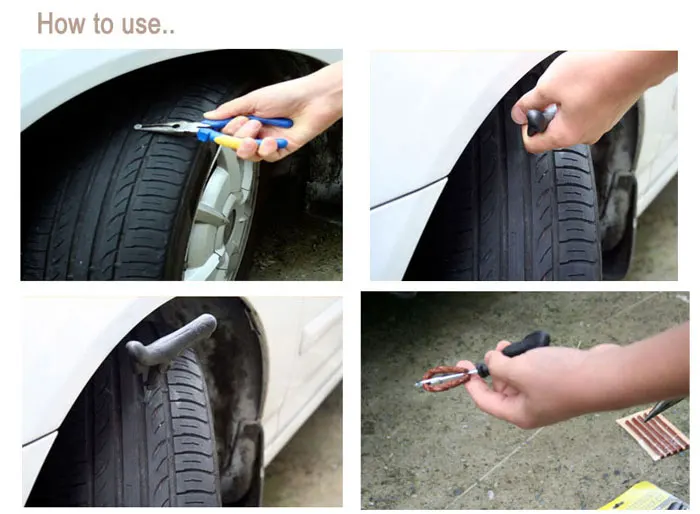 Some are easily repaired, while others are simply impossible to do - the tire can only be sent to the trash.
Some are easily repaired, while others are simply impossible to do - the tire can only be sent to the trash.
A bulge on a wheel, referred to by drivers as a bump or bulge, is the most common tire sidewall defect. It appears due to a collision with an obstacle or after falling into a pit, more often at high speed. The threads of the sidewall carcass are easily damaged by impact, and the tire at this point can no longer hold the load and air pressure - swelling appears. A small bump sooner or later turns into a big one, and driving with such a defect is dangerous - the wheel can shoot at any moment. At high speed, this is fraught with loss of control, departure from the road and a rollover.
The quality of roads in Kazakhstan contributes to the appearance of bulges on tires
Some types of bulges are repairable, although this is a temporary measure. Not a single patch can restore the factory rigidity. Ideally, change the tire.
Special cord patches can extend the life of a tire with a herniation, even if the swelling has appeared on the tread.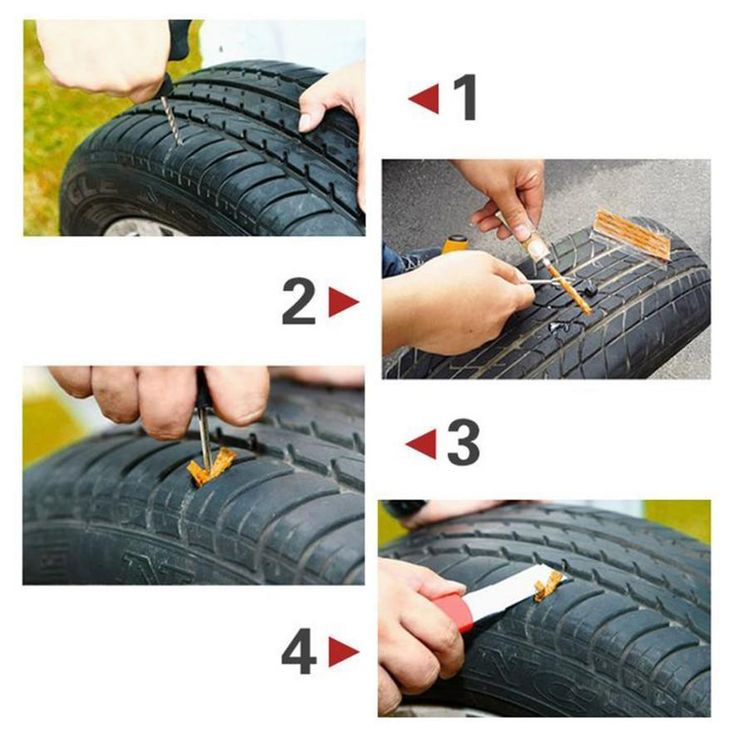 The sidewall is a different story. If the swelling appeared at a distance of more than 40 mm from the side, it can be repaired. If not, then the wheel needs to be replaced. Blisters on low profile tires are most often non-repairable.
The sidewall is a different story. If the swelling appeared at a distance of more than 40 mm from the side, it can be repaired. If not, then the wheel needs to be replaced. Blisters on low profile tires are most often non-repairable.
For maximum safety when riding with a repaired bump, insert the tube. This is an inexpensive and reliable solution. On our market, you can find cameras made in China and Russia, the latter are slightly more expensive, but also of better quality.
The elimination of a side cut is a serious operation, therefore, as in the case of a bump, you will have to go to the professionals. We need cord patches, fortunately in our time they are of different sizes and with a different number of layers. And if you do it wisely, then you can't do without special tools and vulcanization.
A cut, by the way, cannot be healed in all cases. If the gap is in the shoulder area of the tire, it is unlikely that anyone will undertake to repair it, since no guarantees can be given here.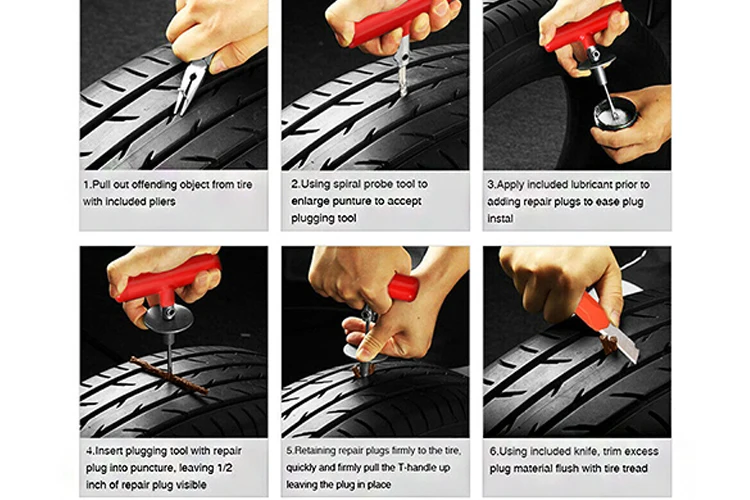 However, our Kulibins take on even the most difficult cases, cutting out parts of the sidewalls from the tires and even weaving the cord on their own.
However, our Kulibins take on even the most difficult cases, cutting out parts of the sidewalls from the tires and even weaving the cord on their own.
Tire overhaul. We would not put such a wheel on ourselves
Low profile tires can be repaired, but more difficult. A tear in the sidewall is easier to seal on tires with a medium or high profile.
Sometimes a cut is confused with a pluck. This is when the outer layer of the sidewall caught on something sharp, a tear formed, but the frame itself remained intact. There is nothing wrong with that, although the drivers at the tire fitting company successfully repair the cut, for which they take it accordingly.
If a piece of rubber remains on the sidewall, then glue it with ordinary superglue (101st). If it came off, then it is better to cover it with raw rubber and vulcanize. Leaving the pluck bare is not recommended, because the tire carcass, often consisting of a metal cord, will quickly corrode.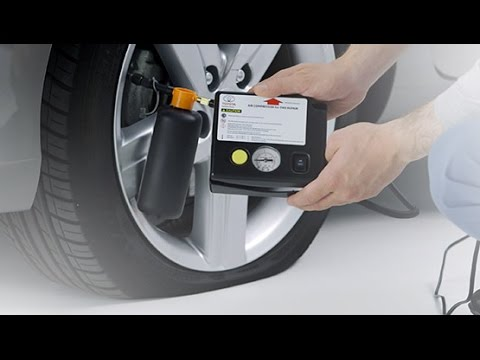
In Europe, defective or used tires are perforated before being sent to the scrapyard to prevent their resale and possible operation. But they don’t know that we have such holes on the sidewall patched once or twice
Cuts and hernias are not the only possible damage to the side of the tire. You can also spoil the side ring, in the process of changing shoes, for example. If it’s for garlic, then such a tire is already dangerous. Sooner or later, the tire pressure and the load in motion will start to squeeze the rubber off the rim - a wheel explosion can occur.
This ailment is repaired if the wire ring - the base - is intact. There are no special technologies and materials to correct this particular problem, but most often craftsmen use a two-component composition for chemical (also called cold) vulcanization. After mixing, the mass is pressed into a fat-free damage. Compound manufacturers recommend waiting 72 hours before mounting a tire. Of course, our masters do not pay attention to this condition - they put the tire right away. And it’s good if the wheel is flat because of this at night in the parking lot, and not on the road.
Of course, our masters do not pay attention to this condition - they put the tire right away. And it’s good if the wheel is flat because of this at night in the parking lot, and not on the road.
If the side ring tears are barely noticeable, but the wheel still deflates, then you can use a special liquid - a bead seal designed to seal a tubeless tire.
These seals have been used in motorsport for some time. In particular, in the American Formula D Drift Series, drivers used compounds to keep the tire on the rim even with minimal tire pressure. Now they are banned.
Pay attention to the left rear wheel of the Nissan Silvia S13. Due to too low pressure, it was literally taken off the disk under load
Every schoolchild faced this problem when patching the tube of his bike after hitting something sharp. Repairing a car tire puncture with your own hands will also not be difficult even on the road. But for this you will need a pump (or compressor) and a universal tire repair kit with harnesses. All this is sold at any car market or gas station.
All this is sold at any car market or gas station.
Repairing a tire on the side of the road with harnesses
The process is simple. If we are talking about the front wheels, then in most cases the wheel can not even be removed, it is enough to turn the steering wheel in the right direction, find the puncture site and carry out repairs. First, the hole is cleaned with a helical awl from the set. The tourniquet itself is smeared with glue and tucked into the eye of the awl, after which it is inserted into the tire hole. With a sharp movement, the tool is removed, and the tourniquet remains in place and clogs the hole. The tails are cut with a knife, but not at the root, it is recommended to leave about 20 mm. The tire is inflated and checked.
Sometimes a nail or self-tapping screw clogs the hole itself, remaining in it. If you see a hat in a tread, do not rush to pull it out. While the pressure is holding, move to vulcanize. And sometimes they drive with a screw in a tire for weeks.
Repair of a puncture at a tire shop
Punctures are also repaired with harnesses at a specialized service, although among professionals such repairs are not considered long-term. After a few months, the flagella dry out and can let air through. There are more advanced methods like cold and hot vulcanization. The latter is more reliable. In this case, the hole is sealed with an elastic plaster, and the funnel from a foreign object is filled with a special compound. After that, a vulcanizer is put on the tire, it heats up the rubber and solders it.
In addition to the plaster, the puncture is also repaired with special cord fungi. Craftsmen process the puncture site: drill it and treat the surface with a tool to roughen it. Then the repair area is lubricated with glue (it is also called cement) and a fungus is introduced. This is done from the inside of the tire. The cap of the fungus is rolled, and the excess legs are simply cut off from the outside.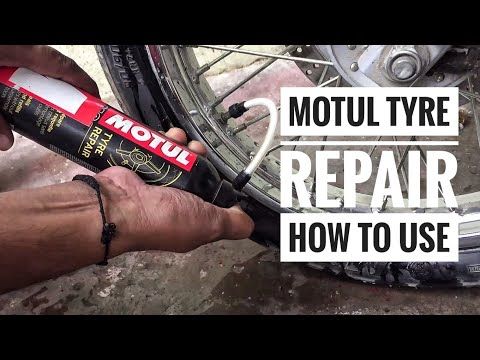
Repairing a puncture with sealant
With the advent of tubeless wheels, and later run flat tires, many automakers began to abandon spare wheels. Instead, repair kits with compressors are supplied with the machines. A repair kit is essentially a bottle of pressurized sealant. Later, such spray cans began to appear on the shelves of ordinary car dealerships.
This method has not taken root in the CIS, because the condition of the roads makes it necessary to have at least a stowaway in the kit, but it can also be considered as a method of repair on the road.
The car must be jacked up and sealant must be pumped into the damaged wheel through the nipple. Next, you should spin the wheel, then pump it up, lower the car and drive a few hundred meters. If the tire tightness has not been restored, repeat the procedure.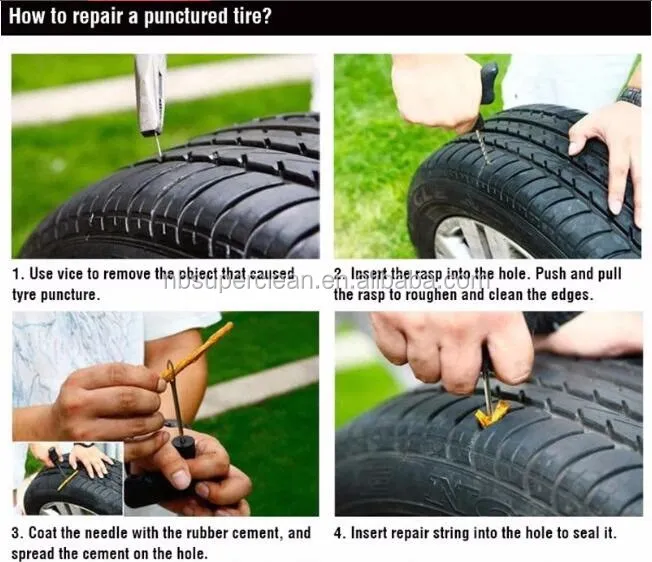
For commercial vehicles, cutting the tread with a special device (regrower) is a common thing. Moreover, such tire retreading is provided by the factory (marked REGROOVABLE on the sidewall) to increase the service life. But there are entrepreneurs who undertake to deepen the grooves in tires for passenger cars. But they are not intended for such an operation. Often used tires for sale are “refreshed” in this way. Be careful!
What is the danger?
The worst case is that the retreaded tire will shoot out on the road, because when deepening the grooves, the master can damage the undertread layer. Such a tire will not be able to hold pressure at some point. There will be a boom! At best, the tire will indeed last a little longer, but is the game worth the candle? We think it's not worth it.
How is cutting made?
A regrower is used to cut the tread. Roughly speaking, this is a large soldering iron with interchangeable tips of various shapes.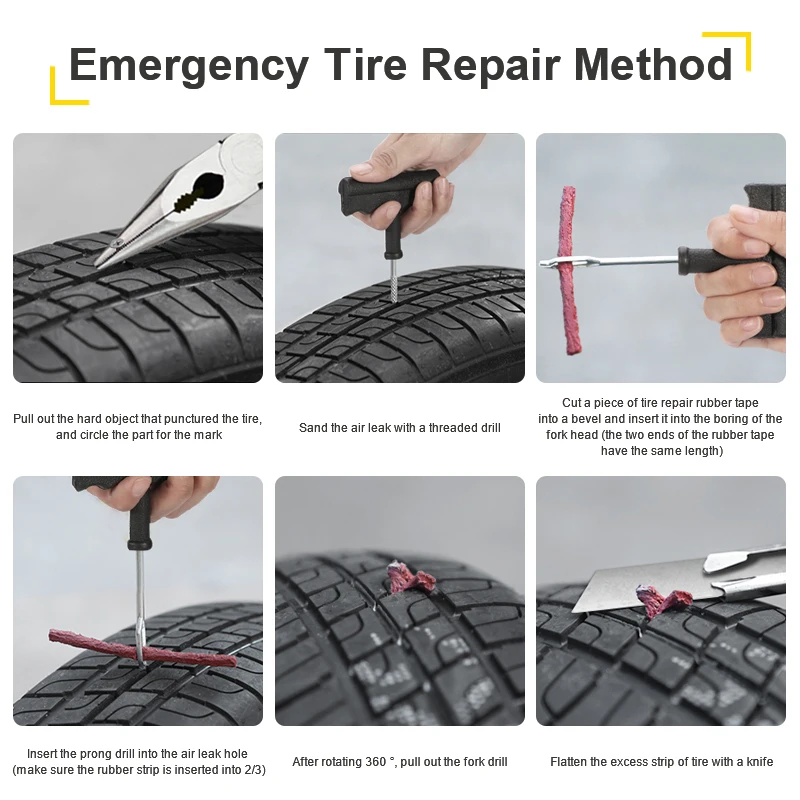 It goes through rubber like a knife through butter.
It goes through rubber like a knife through butter.
If the tire is for passenger cars, then it is worth taking on a regrower only in one case - when part of the tread pattern was welded with “new” rubber during repair. This is where threading comes in handy in order to restore the grooves and symmetry of the tread.
Vehicle operation is prohibited if:
— tires have a residual tread height of less than 1.6 mm;
- tires have punctures, cuts, ruptures that expose the cord, as well as delamination of the carcass, delamination of the tread and sidewall;
- tires in size or load capacity do not match the car model;
- tires of various sizes, designs (radial, diagonal, chamber, tubeless), models, with different tread patterns, winter and summer, studded and non-studded, new and restored, are installed on one axle of the car;
— Tires retreaded according to the second repair class are installed on the front axle.